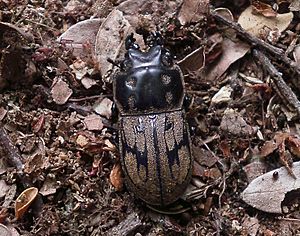New Zealand reticulate stag beetle facts for kids
Paralissotes reticulatus, also called the New Zealand reticulate stag beetle, is a special type of stag beetle that lives only in New Zealand. Even though these beetles have wings, they can't fly! They are a fascinating part of New Zealand's unique insect world.
Quick facts for kids New Zealand reticulate stag beetle |
|
|---|---|
 |
|
| Illustrated by Des Helmore | |
| Scientific classification | |
| Kingdom: | |
| Phylum: | |
| Class: | |
| Order: | |
| Family: | |
| Subfamily: |
Lucaninae
|
| Genus: | |
| Species: |
P. reticulatus
|
| Binomial name | |
| Paralissotes reticulatus (Westwood, 1844)
|
|
| Synonyms | |
|
|
Naming This Beetle
Scientists give every living thing a special name. This helps them organize and study all the different plants and animals on Earth. This beetle was first described by a scientist named John O. Westwood in 1844. He first called it Lucanus reticulatus. Later, in 1995, it was moved into the group (or genus) called Paralissotes.
What Does It Look Like?

These beetles are small to medium-sized. If you include their mandibles (their strong jaws), male beetles can be about 1.2 to 2.1 centimeters long. Female beetles are similar, measuring about 1.3 to 2.1 centimeters.
They have a shiny black exoskeleton, which is like a hard outer shell that protects their body. The name "reticulate" comes from the cool pattern on their body. It looks like a network of raised and lowered areas. Their head is widest just in front of their eyes. Both male and female beetles have mandibles that are about the same size.
Like other beetles in the Paralissotes group, this beetle has small, undeveloped wings. These wings are called "vestigial" because they are left over from ancestors, but they don't actually work for flying. So, even though they have wings, these beetles stay on the ground!
Where Do They Live?
The New Zealand reticulate stag beetle is the most common and widespread species in its group. You can find them in many places across New Zealand. They have been collected from the Bay of Plenty in the North Island all the way down to South Canterbury in the South Island. Recently, some have even been found near Dunedin.
These beetles live in many different environments, from areas close to the sea up to about 950 meters high in the mountains.
Habitat and Habits
Like other stag beetles, adult Paralissotes reticulatus beetles are often found hiding under decaying logs of native trees. This means logs that are slowly rotting away. The young beetles, called larvae, live inside this rotting wood. They eat the decaying wood as they grow.
These beetles are mostly active at night. This means you are more likely to see them after the sun goes down. However, sometimes you might spot them during the day, especially if the weather is wet.
See also
 In Spanish: Paralissotes reticulatus para niños
In Spanish: Paralissotes reticulatus para niños


